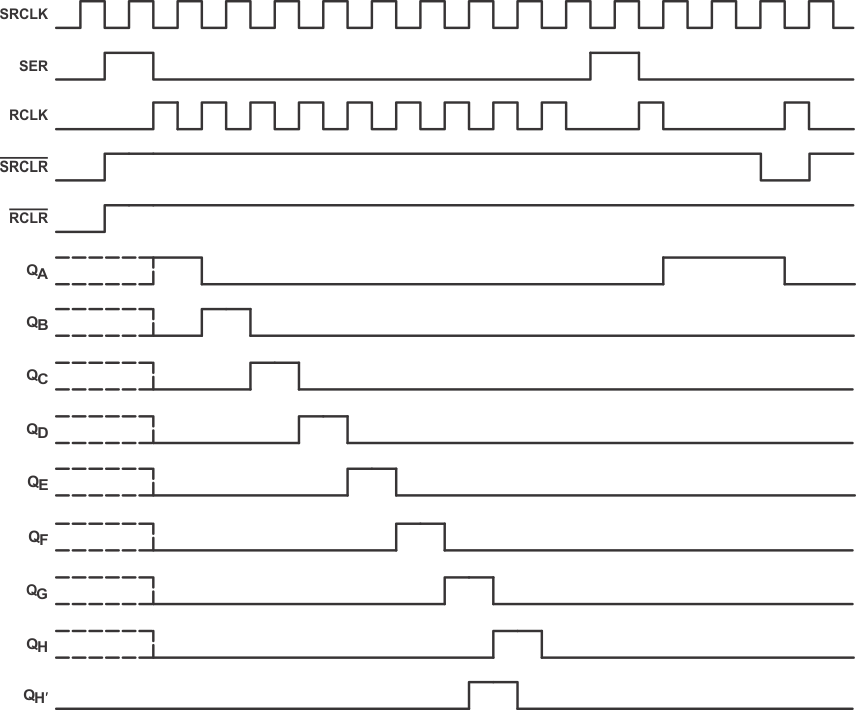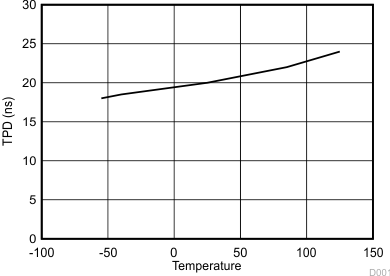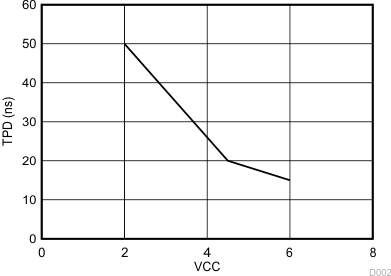SCLS040G December 1982 – March 2015 SN74HC594
UNLESS OTHERWISE NOTED, this document contains PRODUCTION DATA.
- 1 Features
- 2 Applications
- 3 Description
- 4 Revision History
- 5 Pin Configuration and Functions
-
6 Specifications
- 6.1 Absolute Maximum Ratings
- 6.2 ESD Ratings
- 6.3 Recommended Operating Conditions
- 6.4 Thermal Information
- 6.5 Electrical Characteristics
- 6.6 Switching Characteristics: CL = 50 pF
- 6.7 Switching Characteristics: CL = 150 pF
- 6.8 Timing Requirements
- 6.9 Operating Characteristics
- 6.10 Typical Characteristics
- 7 Parameter Measurement Information
- 8 Detailed Description
- 9 Application and Implementation
- 10Power Supply Recommendations
- 11Layout
- 12Device and Documentation Support
- 13Mechanical, Packaging, and Orderable Information
封装选项
请参考 PDF 数据表获取器件具体的封装图。
机械数据 (封装 | 引脚)
- DW|16
- N|16
- D|16
散热焊盘机械数据 (封装 | 引脚)
- DW|16
订购信息
6 Specifications
6.1 Absolute Maximum Ratings(1)
over operating free-air temperature range (unless otherwise noted)| MIN | MAX | UNIT | |||
|---|---|---|---|---|---|
| VCC | Supply voltage | –0.5 | 7 | V | |
| IIK | Input clamp current(2) | VI < 0 or VI > VCC | –20 | 20 | mA |
| IOK | Output clamp current(2) | VO < 0 or VO > VCC | –20 | 20 | mA |
| IO | Continuous output current | VO = 0 to VCC | –35 | 35 | mA |
| Continuous current through VCC or GND | –70 | 70 | mA | ||
| θJA | Package thermal impedance(3) | D package | 73 | °C/W | |
| DW package | 57 | ||||
| N package | 67 | ||||
| Tstg | Storage temperature | –60 | 150 | °C | |
(1) Stresses beyond those listed under Absolute Maximum Ratings may cause permanent damage to the device. These are stress ratings only, which do not imply functional operation of the device at these or any other conditions beyond those indicated under Recommended Operating Conditions. Exposure to absolute-maximum-rated conditions for extended periods may affect device reliability.
(2) The input and output voltage ratings may be exceeded if the input and output current ratings are observed.
(3) The package thermal impedance is calculated in accordance with JESD 51-7.
6.2 ESD Ratings
| VALUE | UNIT | |||
|---|---|---|---|---|
| V(ESD) | Electrostatic discharge | Human body model (HBM), per ANSI/ESDA/JEDEC JS-001(1) | ±2000 | V |
| Charged-device model (CDM), per JEDEC specification JESD22-C101(2) | ±1000 | |||
(1) JEDEC document JEP155 states that 500-V HBM allows safe manufacturing with a standard ESD control process.
(2) JEDEC document JEP157 states that 250-V CDM allows safe manufacturing with a standard ESD control process.
6.3 Recommended Operating Conditions
over operating free-air temperature range (unless otherwise noted)(1)| SN54HC594(2) | SN74HC594 | UNIT | |||||||
|---|---|---|---|---|---|---|---|---|---|
| MIN | NOM | MAX | MIN | NOM | MAX | ||||
| VCC | Supply voltage | 2 | 5 | 6 | 2 | 5 | 6 | V | |
| VIH | High-level input voltage | VCC = 2 V | 1.5 | 1.5 | V | ||||
| VCC = 4.5 V | 3.15 | 3.15 | |||||||
| VCC = 6 V | 4.2 | 4.2 | |||||||
| VIL | Low-level input voltage | VCC = 2 V | 0.5 | 0.5 | V | ||||
| VCC = 4.5 V | 1.35 | 1.35 | |||||||
| VCC = 6 V | 1.8 | 1.8 | |||||||
| VI | Input voltage | 0 | VCC | 0 | VCC | V | |||
| VO | Output voltage | 0 | VCC | 0 | VCC | V | |||
| tt | Input transition (rise and fall) rate | VCC = 2 V | 1000 | 1000 | ns | ||||
| VCC = 4.5 V | 500 | 500 | |||||||
| VCC = 6 V | 400 | 400 | |||||||
| TA | Operating free-air temperature | –55 | 125 | –40 | 125 | °C | |||
(1) All unused inputs of the device must be held at VCC or GND to ensure proper device operation. Refer to the TI application report, Implications of Slow or Floating CMOS Inputs, SCBA004.
(2) Product Preview
6.4 Thermal Information
| THERMAL METRIC(1) | SN74HC594 | UNIT | |||
|---|---|---|---|---|---|
| N (PDIP) | D (SOIC) | DW (SOIC) | |||
| 16 PINS | 16 PINS | 16 PINS | |||
| RθJA | Junction-to-ambient thermal resistance | 41.3 | 72.3 | 71 | °C/W |
| RθJC(top) | Junction-to-case (top) thermal resistance | 28 | 33.2 | 32.3 | |
| RθJB | Junction-to-board thermal resistance | 21.3 | 29.9 | 35.9 | |
| ψJT | Junction-to-top characterization parameter | 12.6 | 5.3 | 6.7 | |
| ψJB | Junction-to-board characterization parameter | 21.1 | 29.6 | 35.3 | |
(1) For more information about traditional and new thermal metrics, see the IC Package Thermal Metrics application report, SPRA953.
6.5 Electrical Characteristics
over recommended operating free-air temperature range (unless otherwise noted)| PARAMETER | TEST CONDITIONS | VCC | TA = 25°C | SN54HC594(1)
–55°C to 125°C |
SN74HC594 –40°C to 85°C |
SN74HC594 –40°C to 125°C |
UNIT | |||||||
|---|---|---|---|---|---|---|---|---|---|---|---|---|---|---|
| MIN | TYP | MAX | MIN | MAX | MIN | MAX | MIN | MAX | ||||||
| VOH | VI = VIH or VIL | IOH = –20 µA | 2 V | 1.9 | 1.998 | 1.9 | 1.9 | 1.9 | V | |||||
| 4.5 V | 4.4 | 4.499 | 4.4 | 4.4 | 4.4 | |||||||||
| 6 V | 5.9 | 5.999 | 5.9 | 5.9 | 5.9 | |||||||||
| QH’ | IOH = –4 mA | 4.5 V | 3.98 | 4.3 | 3.7 | 3.84 | 3.84 | |||||||
| QA – QH | IOH = –6 mA | 3.98 | 4.3 | 3.7 | 3.84 | 3.84 | ||||||||
| QH’ | IOH = –5.2 mA | 6 V | 5.48 | 5.8 | 5.2 | 5.34 | 5.34 | |||||||
| QA – QH | IOH = –7.8 mA | 5.48 | 5.8 | 5.2 | 5.34 | 5.34 | ||||||||
| VOL | VI = VIH or VIL | IOL = 20 µA | 2 V | 0.002 | 0.1 | 0.1 | 0.1 | 0.1 | V | |||||
| 4.5 V | 0.001 | 0.1 | 0.1 | 0.1 | 0.1 | |||||||||
| 6 V | 0.001 | 0.1 | 0.1 | 0.1 | 0.1 | |||||||||
| QH’ | IOL = 4 mA | 4.5 V | 0.17 | 0.26 | 0.4 | 0.33 | 0.33 | |||||||
| QA – QH | IOL = 6 mA | 0.17 | 0.26 | 0.4 | 0.33 | 0.33 | ||||||||
| QH’ | IOL = 5.2 mA | 6 V | 0.15 | 0.26 | 0.4 | 0.33 | 0.33 | |||||||
| QA – QH | IOL = 7.8 mA | 0.15 | 0.26 | 0.4 | 0.33 | 0.33 | ||||||||
| II | VI = VCC or 0 | 6 V | ±0.1 | ±100 | ±1000 | ±1000 | ±1000 | nA | ||||||
| ICC | VI = VCC or 0, | IO = 0 | 6 V | 8 | 160 | 80 | 80 | µA | ||||||
| Ci | 2 V to 6 V |
3 | 10 | 10 | 10 | pF | ||||||||
(1) Product Preview
6.6 Switching Characteristics: CL = 50 pF
over recommended operating free-air temperature range (unless otherwise noted) (see Figure 4)| PARAMETER | FROM (INPUT) |
TO (OUTPUT) |
VCC | TA = 25°C | SN54HC594(1)
–55°C to 125°C |
SN74HC594 –40°C to 85°C |
SN74HC594 –40°C to 125°C |
UNIT | |||||
|---|---|---|---|---|---|---|---|---|---|---|---|---|---|
| MIN | TYP | MAX | MIN | MAX | MIN | MAX | MIN | MAX | |||||
| fmax | 2 V | 5 | 8 | 3.3 | 4 | 4 | MHz | ||||||
| 4.5 V | 25 | 35 | 17 | 20 | 20 | ||||||||
| 6 V | 29 | 40 | 20 | 24 | 24 | ||||||||
| tpd | SRCLK | QH’ | 2 V | 50 | 150 | 225 | 185 | 200 | ns | ||||
| 4.5 V | 20 | 30 | 45 | 37 | 42 | ||||||||
| 6 V | 15 | 25 | 38 | 31 | 36 | ||||||||
| RCLK | QA – QH | 2 V | 50 | 150 | 225 | 185 | 200 | ||||||
| 4.5 V | 20 | 30 | 45 | 37 | 42 | ||||||||
| 6 V | 15 | 25 | 38 | 31 | 36 | ||||||||
| tPHL | SRCLR | QH’ | 2 V | 50 | 150 | 225 | 185 | 200 | ns | ||||
| 4.5 V | 20 | 30 | 45 | 37 | 42 | ||||||||
| 6 V | 15 | 25 | 38 | 31 | 36 | ||||||||
| RCLR | QA – QH | 2 V | 50 | 125 | 185 | 155 | 170 | ||||||
| 4.5 V | 20 | 25 | 37 | 31 | 36 | ||||||||
| 6 V | 15 | 21 | 31 | 26 | 31 | ||||||||
| tt | QH’ | 2 V | 38 | 75 | 110 | 95 | 110 | ns | |||||
| 4.5 V | 8 | 15 | 22 | 19 | 21 | ||||||||
| 6 V | 6 | 13 | 19 | 16 | 18 | ||||||||
| QA – QH | 2 V | 38 | 60 | 90 | 75 | 85 | |||||||
| 4.5 V | 8 | 12 | 18 | 15 | 17 | ||||||||
| 6 V | 6 | 10 | 15 | 13 | 15 | ||||||||
(1) Product Preview
6.7 Switching Characteristics: CL = 150 pF
over recommended operating free-air temperature range (unless otherwise noted) (see Figure 4)| PARAMETER | FROM (INPUT) |
TO (OUTPUT) |
VCC | TA = 25°C | SN54HC594(1)
–55°C to 125°C |
SN74HC594 –40°C to 85°C |
SN74HC594 –40°C to 125°C |
UNIT | |||||
|---|---|---|---|---|---|---|---|---|---|---|---|---|---|
| MIN | TYP | MAX | MIN | MAX | MIN | MAX | MIN | MAX | |||||
| tpd | RCLK | QA – QH | 2 V | 90 | 200 | 300 | 250 | 270 | ns | ||||
| 4.5 V | 23 | 40 | 60 | 50 | 55 | ||||||||
| 6 V | 19 | 34 | 51 | 43 | 48 | ||||||||
| tPHL | RCLR | QA – QH | 2 V | 90 | 200 | 300 | 250 | 270 | ns | ||||
| 4.5 V | 23 | 40 | 60 | 50 | 55 | ||||||||
| 6 V | 19 | 34 | 51 | 43 | 48 | ||||||||
| tt | QA – QH | 2 V | 45 | 210 | 315 | 265 | 285 | ns | |||||
| 4.5 V | 17 | 42 | 63 | 53 | 58 | ||||||||
| 6 V | 13 | 36 | 53 | 45 | 50 | ||||||||
(1) Product Preview
6.8 Timing Requirements
over recommended operating free-air temperature range (unless otherwise noted)| VCC | TA = 25°C | SN54HC594(1)
–55°C to 125°C |
SN74HC594 –40°C to 85°C |
SN74HC594 –40°C to 125°C |
UNIT | |||||||
|---|---|---|---|---|---|---|---|---|---|---|---|---|
| MIN | MAX | MIN | MAX | MIN | MAX | MIN | MAX | |||||
| fclock | Clock frequency | 2 V | 5 | 3.3 | 4 | 4 | MHz | |||||
| 4.5 V | 25 | 17 | 20 | 20 | ||||||||
| 6 V | 29 | 20 | 24 | 24 | ||||||||
| tw | Pulse duration | SRCLK or RCLK high or low | 2 V | 100 | 150 | 125 | 130 | ns | ||||
| 4.5 V | 20 | 30 | 25 | 27 | ||||||||
| 6 V | 17 | 25 | 21 | 23 | ||||||||
| SRCLR or RCLR low | 2 V | 100 | 150 | 125 | 130 | |||||||
| 4.5 V | 20 | 30 | 25 | 27 | ||||||||
| 6 V | 17 | 25 | 21 | 23 | ||||||||
| tsu | Setup time before CLK↑ | SER before SRCLK↑ | 2 V | 90 | 135 | 110 | 115 | ns | ||||
| 4.5 V | 18 | 27 | 22 | 24 | ||||||||
| 6 V | 15 | 23 | 19 | 21 | ||||||||
| SRCLK↑ before RCLK↑(2) | 2 V | 90 | 135 | 110 | 115 | |||||||
| 4.5 V | 18 | 27 | 22 | 24 | ||||||||
| 6 V | 15 | 23 | 19 | 21 | ||||||||
| SRCLR low before RCLK↑ | 2 V | 50 | 75 | 63 | 68 | ns | ||||||
| 4.5 V | 10 | 15 | 13 | 15 | ||||||||
| 6 V | 9 | 13 | 11 | 13 | ||||||||
| SRCLR high (inactive) before SRCLK↑ | 2 V | 20 | 20 | 20 | 20 | |||||||
| 4.5 V | 10 | 10 | 10 | 10 | ||||||||
| 6 V | 10 | 10 | 10 | 10 | ||||||||
| RCLR high (inactive) before SRCLK↑ | 2 V | 5 | 5 | 5 | 5 | |||||||
| 4.5 V | 5 | 5 | 5 | 5 | ||||||||
| 6 V | 5 | 5 | 5 | 5 | ||||||||
| th | Hold time, SER after SRCLK↑ | 2 V | 5 | 5 | 5 | 5 | ns | |||||
| 4.5 V | 5 | 5 | 5 | 5 | ||||||||
| 6 V | 5 | 5 | 5 | 5 | ||||||||
(1) Product Preview
(2) This setup time ensures that the output register receives stable data from the shift-register outputs. The clocks may be tied together, in which case the output register is one clock pulse behind the shift register.
6.9 Operating Characteristics
TA = 25°C| PARAMETER | TEST CONDITIONS | TYP | UNIT | |
|---|---|---|---|---|
| Cpd | Power dissipation capacitance | No load | 395 | pF |
 Figure 1. Timing Diagram
Figure 1. Timing Diagram
6.10 Typical Characteristics
 Figure 2. SN74HC594 TPD vs. Temperature
Figure 2. SN74HC594 TPD vs. Temperature
 Figure 3. SN74HC594 TPD vs. VCC
Figure 3. SN74HC594 TPD vs. VCC